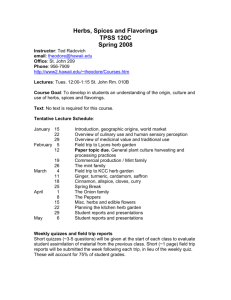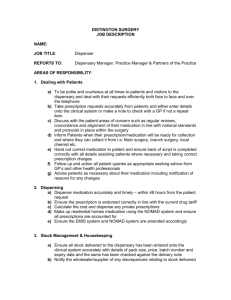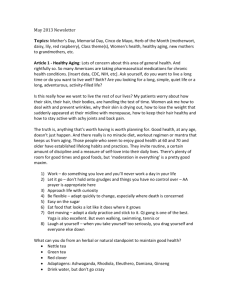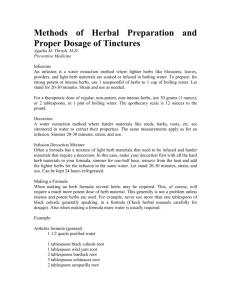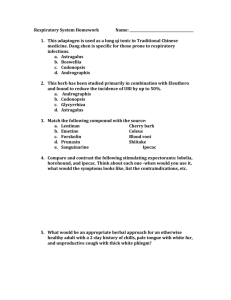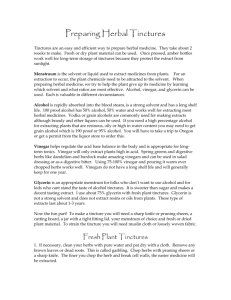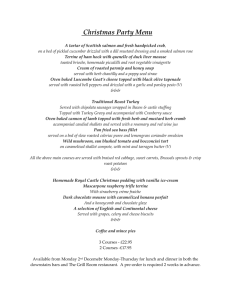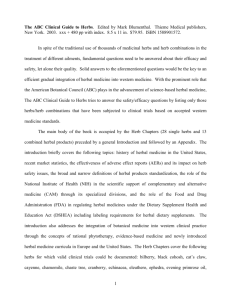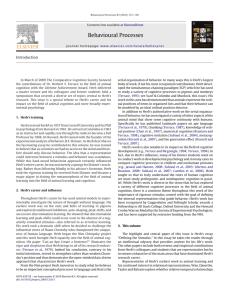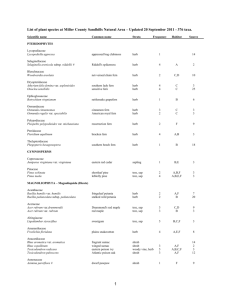introduction - European Herbal & Traditional Medicine Practitioners
advertisement
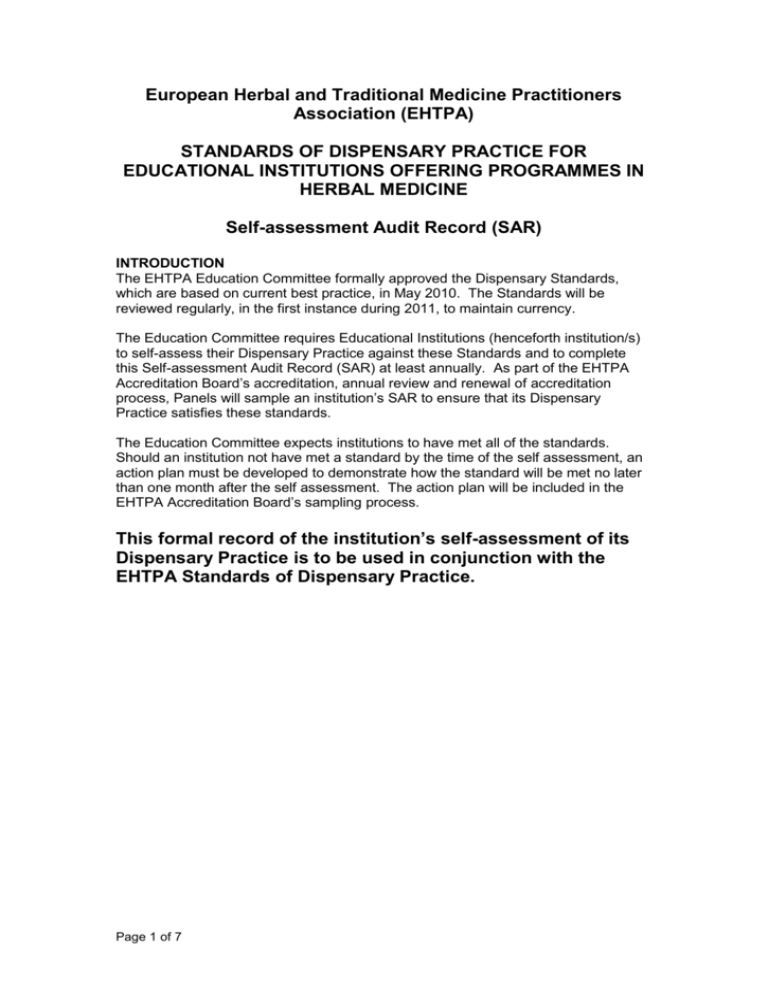
European Herbal and Traditional Medicine Practitioners Association (EHTPA) STANDARDS OF DISPENSARY PRACTICE FOR EDUCATIONAL INSTITUTIONS OFFERING PROGRAMMES IN HERBAL MEDICINE Self-assessment Audit Record (SAR) INTRODUCTION The EHTPA Education Committee formally approved the Dispensary Standards, which are based on current best practice, in May 2010. The Standards will be reviewed regularly, in the first instance during 2011, to maintain currency. The Education Committee requires Educational Institutions (henceforth institution/s) to self-assess their Dispensary Practice against these Standards and to complete this Self-assessment Audit Record (SAR) at least annually. As part of the EHTPA Accreditation Board’s accreditation, annual review and renewal of accreditation process, Panels will sample an institution’s SAR to ensure that its Dispensary Practice satisfies these standards. The Education Committee expects institutions to have met all of the standards. Should an institution not have met a standard by the time of the self assessment, an action plan must be developed to demonstrate how the standard will be met no later than one month after the self assessment. The action plan will be included in the EHTPA Accreditation Board’s sampling process. This formal record of the institution’s self-assessment of its Dispensary Practice is to be used in conjunction with the EHTPA Standards of Dispensary Practice. Page 1 of 7 Name of institution: Date of self-assessment: 1.0 PERSONNEL 1. Clinical and dispensary staff are appropriately educated and/or experienced. Yes No 2. Job descriptions are present. Yes No 3. Training records are present. Yes No 4. Performance reviews are held annually. Yes No 5. Review records are retained for 7 years. Yes No 2.0 PREMISES, EQUIPMENT, HYGIENE AND STORAGE 1. Good Manufacturing Practice is followed in all cleaning procedures and house keeping practices. Yes No 2. The premises are located, designed and constructed to suit their intended purpose. Yes No 3. The equipment, including measuring equipment, is located, designed, constructed and maintained to meet its intended purpose. Yes No 4. Environmental standards and conditions of temperature and humidity are monitored and recorded regularly. Yes No 5. Direct contact with raw herbs and herbal products is avoided. Yes No 6. Clothing is designed to protect both product and personnel. Yes No 7. Clothing is clean and changed whenever necessary. Yes No 8. Personnel suffering from an infectious disease or having open lesions on the exposed surface of the body avoid engaging in activities that could compromise the quality of the product. Yes No Page 2 of 7 9. Smoking, drinking, eating, chewing gum and storage of food are restricted to designated areas separate from the Storage, Handling and Dispensing areas. Yes No 10. Changing, washing, toilet and refreshment rooms are separate from Storage, Handling and Dispensing areas. Yes No 11. Areas used to store or control raw herbs, herb products and packaging materials are kept clean and tidy. Yes No 12. Product contact surfaces are easily cleanable. Yes No 13. Surfaces and equipment are protected from recontamination and checked for cleanliness before use. Yes No 14. Storage and dispensing conditions are such that the growth and multiplication of pathogenic or spoilage micro-organisms are minimised. Yes No 15. There is adequate and demonstrable pest control in all the relevant parts of the institution. Yes No 3.0 LABELLING OF PRODUCT 1. All herb products include a batch number and best-before date. Yes No 2. Where appropriate, all herb products include the botanical name and pinyin, with the part of the plant used, e.g. Paeonia lactiflora (root). Yes No 3. All herb material includes the name and contact details of the supplier. Yes No 4. Warnings are included if for External use only. Yes No 5. Breaking bulk: all of the above information is transferred to material removed from the original supply and/or a record of this information is available, that is, the correct information is on the dispensing container. Yes No 4.0 AUTHENTICATION 1. The institution assesses the authentication of the incoming herb material by visual inspection and other appropriate organoleptic tests. Yes No Page 3 of 7 2. The institution has an appropriately trained member of staff to oversee this inspection. Yes No 3. The institution has adheres to the Codes of Practice on Scheduled Herbs. Yes No 5.0 DISPENSARY SERVICE 1. Appropriate standardised prescription forms are used. Yes No 2. Herb audit information including changes in batches during prescriptions is recorded. Yes No 3. A Prescription order number for future reference is retained for a specified period. Yes No 4. Labelling on herb batches sent to patients includes the name and address of institution/prescription order number/ date. Yes No 5. Documentation relating to traceability is retained for 7 years. Yes No 6. Evidence of current and recent training of Dispensary staff is available. Yes No 6.0 RECORD KEEPING 1 Quality records are correctly identified. Yes No 2 Quality records are suitably stored. Yes No 3 Quality records are readily available. Yes No 4 Documentation exists for all processes that have an effect on the quality of herbs and herb products. Yes No 5 There is a written procedure for regular review and updating of all documentation. Yes No 6 All procedures are approved by the relevant member of staff. Yes No 7 All information and documentation is up to date and current. Yes No Page 4 of 7 8 The institution has a procedure for maintaining the currency of its documentation. Yes No 9 At least one member of staff is responsible for document control. Yes No 10 All hand-written corrections are signed and dated. Yes No 11 There is adequate protection of all records from water, microbial and fire damage. Yes No 12 A Herb Audit trail is in place. Yes No 13 The Herb Trail records continuity of batch numbers between receipt and dispensing. Yes No 14 The Herb Trail includes prescription records. Yes No 15 The institution retains Herb Trail documentation for 7 years. Yes No 16 A Yellow Card warning system is in operation. Yes No 7.0 COMPLAINTS AND RECALL PROCEDURES 1. There is a documented complaints procedure. Yes No 2. There is a documented product recall procedure. Yes No 8.0 TRAINING 1. Qualification and training needs are: i) Identified. Yes No ii) Documented. Yes No iii) Regularly reviewed. Yes No 2. Dispensary training is repeated at prescribed intervals for all relevant personnel. Yes No Page 5 of 7 3. Training records: i) Follow Good Manufacturing Practice documentation guidelines. Yes No ii) Are retained for the prescribed period. Yes No 9.0 CORRECTIVE AND PREVENTATIVE ACTION 1 The causes of actual and potential non-conformance in the quality system are identified. Yes No 2 The causes of actual and potential non-conformance in the quality system are eliminated. Yes No 3 The action is appropriate to the severity of the non-conformance. Yes No 4 Changes resulting from corrective and/ or preventative action are documented. Yes No 5 The records relating to changes are retained for 7 years. Yes No 10.0 HANDLING, STORAGE, PACKAGING, PRESERVATION AND DELIVERY 1. Incoming materials are not mixed with existing stocks until they have been inspected. Yes No 2. Herbs and herb products are handled in an environment giving protection against contamination. Yes No 3. There are secure storage facilities that prevent damage or deterioration of materials. Yes No 4. The storage facilities are clean and tidy. Yes No 5. The storage facilities are subject to appropriate pest control measures. Yes No 6. The ‘First in, First Out’ or ‘First Expired, First Out’ method of stock control is used. Yes No 7. Receipt and despatch into and out of storage are authorised. Yes No Page 6 of 7 8. Receipt and despatch into and out of storage recorded. Yes No 9. The condition of stored material is assessed for degradation at appropriate intervals. Yes No 10. Storage procedures ensure segregation of materials. Yes No 11. Materials that have been rejected or recalled are physically segregated from other stock until their final disposition has been determined. Yes No 12. Herbs that are used solely for the purpose of teaching are identified and segregated from the stock used for dispensing. Yes No 13. Marking and labelling are legible and durable. Yes No 14. Marking and labelling provide sufficient information for accurate identification and indicate, if appropriate, required storage conditions and expiry date. Yes No 15. Tracking records of dispensed items are maintained for 7 years. Yes No 11.0 CHANGE CONTROL 1. The institution has established a system for controlling change. Yes No 12.0 COMMUNICATIONS 1 The institution has a means of communicating effectively with its supply companies. Yes No 2 The institution has a means of communicating effectively with the professional associations and regulatory bodies. Yes No 13.0 REFERENCE MATERIALS 1 All the relevant reference materials are available. Yes No Page 7 of 7
